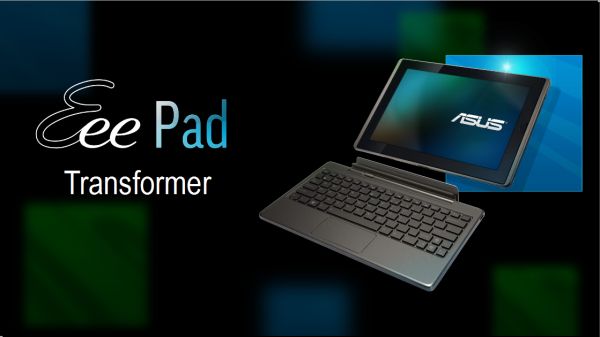ASUS Announces Eee Pad and Eee Slate Tablets
by Vivek Gowri on January 4, 2011 5:42 PM ESTThe Transformer is going to be the volume seller of the Eee Pad family. It sits squarely in the 10” Tegra 2 Android slate class, which is basically becoming the tablet equivalent of the mid-size car segment. The Transformer, at first glance, looks fairly standard, but it’s got a couple of features that set it apart. We’ll get to those in a bit, but let’s look at the specs first.
Honeycomb and Tegra 2 are a given, with 512MB and 1GB RAM options available. The on-board flash storage comes in 16GB, 32GB, and 64GB sizes. The 10” screen is a WXGA (1280x800) IPS unit with 178 degree viewing angles. Again, ASUS uses IPS here—we’ll see how many of the others are using IPS displays, but given the $399 starting price, it’s nice to see that as a standard feature.
The same 5MP rear and 1.2MP front cameras from the MeMO are present on the Transformer too, though the LED flash apparently didn’t make it. There’s 2.4GHz 802.11n and Bluetooth 2.1 radios, but no word on built-in 3G connectivity. We’ll be sure to ask ASUS about it when we meet them at CES, but it’s difficult to imagine them shipping without mobile data as an option. The Transformer has a decent list of ports too—mini-HDMI, a combo audio/mic jack, an internal mic, micro-USB, SDHC card reader, and a docking port.
The docking port is where the Transformer gets interesting (and where it gets its name from). The Transformer has an optional keyboard docking station that effectively turns it into an Android netbook. It’s a pretty attractive piece of kit when it’s all put together, but I’m not sure how useful the touchpad will be in Android. Honeycomb might change that, but we’ll need to wait to find out more about it. The docking station contains a second battery that doubles the Transformer’s quoted 8-hour battery life, as well as some extra ports (I spied an extra USB port on the right side). The dock is an optional extra that I’m guessing will be in the range of $99 to $149, but if you’re planning on using a keyboard on the go, it’s probably well worth the money.
Speaking of pricing, the Transformer starts at $399. That sum will presumably get you the base 16GB/512MB RAM slate, while the other storage, connectivity, and memory options can push the cost up to $699. But at the entry level, you get a tablet with solid specs and an IPS display for $399, meaning that when it starts shipping in Q2, the base Transformer will definitely be a tablet to be reckoned with.











37 Comments
View All Comments
vol7ron - Tuesday, January 4, 2011 - link
As with all things computing, the success hinders on options and price. They have to give enough of the former and reduce enough of the later.True belief: pad/netbook devices need a smaller profit margin.
michael2k - Tuesday, January 4, 2011 - link
The high profit margin is the only reason that anyone is entering the market. Without the high profit margin, no one would introduce a single, let alone four, products.Let the early adopters pay the high margin if that is what concerns you.
MobiusStrip - Wednesday, January 5, 2011 - link
GPS. EVERY tablet should have GPS. Tablets are little more than a gimmick, but the addition of GPS would add solid value at very little cost to the manufacturer. Not to mention beating Apple, which irritatingly omitted GPS from half the iPads.Any vendor that fails to take this obvious step doesn't deserve your dollars, and their products aren't going to be around long anyway.
tipoo - Tuesday, January 4, 2011 - link
On the spec sheet next to battery life they probably just write "No".JarredWalton - Tuesday, January 4, 2011 - link
Except we got pretty good battery life from the ASUS U30Jc, and the UL80Jt, and.... It will depend on how big the battery is, but the i5-470UM ought to be able to hit at least five hours on a ~30Wh battery.VivekGowri - Tuesday, January 4, 2011 - link
Yeah, they didn't actually mention battery life, indicating that it's probably not very good.....Unfortunate, but it's a reality. I think Windows slates are going to be doomed to mediocre battery life - Intel chips aren't low-power enough for tablets (yet). That'll change with Moorestown and Oak Trail, but right now they just can't compete with ARM as far as handheld battery life.halcyon - Wednesday, January 5, 2011 - link
Well, Asus pretty much wrote "no" in the specs of Eee Slate EP121:Battery life: up to 3 hours (under specific conditions, which you can easily guess what those are)
In real life usage that is going to mean less than 2 hours of battery life.
If that is not a FAIL for a tablet, I don't know what is.
tipoo - Wednesday, January 5, 2011 - link
Yeah, three hours is what I would consider bad in a laptop, let alone a tablet.headbox - Tuesday, January 4, 2011 - link
I predict Zune-like sales if they're lucky.bplewis24 - Tuesday, January 4, 2011 - link
Anybody else find it interesting that Asus is going with IPS displays across the board here when they generally do not use IPS displays in their mainstream desktop monitor line of products?Does this signify a shift in focus that will carry over to their desktop monitors or will it be exclusive to their tablet/slate product line?
Brandon